Ask Ethan: Can star radiation losses explain dark energy?
- Transfer
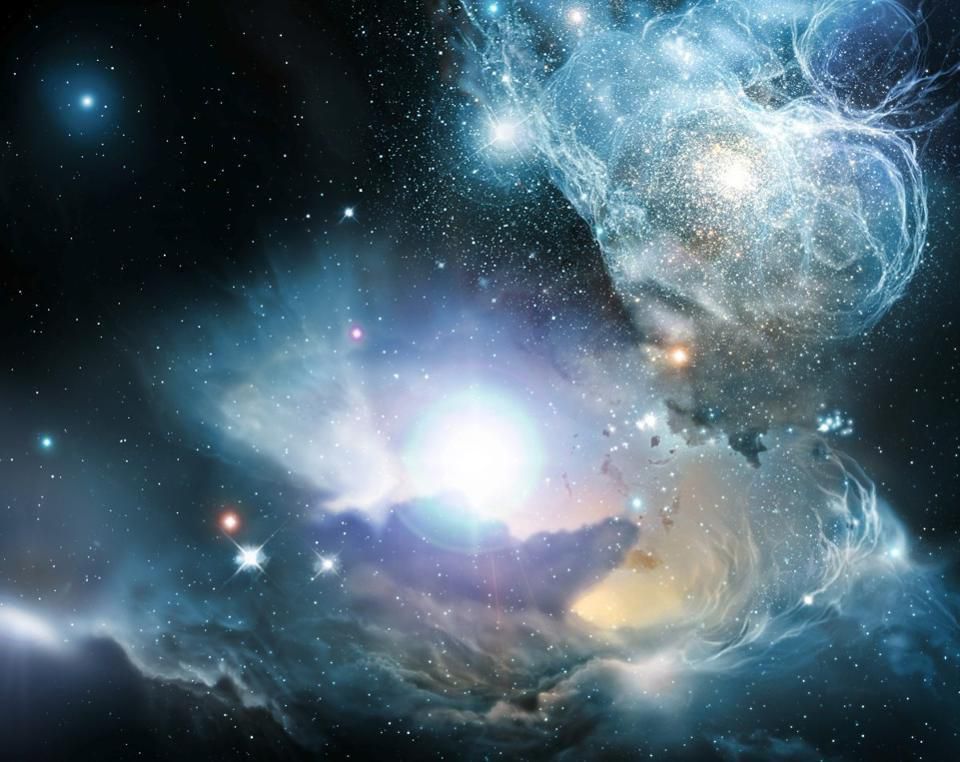
Representation of the artist about those times of the Universe, in which the first stars were formed. Because of their light and fusions, they will emit radiation, both electromagnetic and gravitational. But is the transformation of matter into energy capable of creating antigravity?
On the way of our knowledge of the universe there are riddles, the answer to which is not yet known to anyone. Dark matter, dark energy, cosmic inflation — all these ideas are incomplete, and we do not know what type of particles or fields are responsible for them. It is possible, although most professionals find it unlikely that one or more of these puzzles may have a non-standard solution that none of us expect.
For the first time in the history of the column “Ask Ethan,” I received a question from a Nobel laureate -John Cromwell Mather - who wants to know whether stars, transforming mass into energy, can be responsible for the effects attributed to dark energy:
What happens to the gravity that the vanishing mass has in the process of transforming it into light and neutrinos by nuclear reactions occurring in stars, or when the mass is going into a black hole, or when it turns into gravitational waves? In other words, are gravitational waves, electromagnetic waves and neutrinos a source of gravity, which exactly coincides with the mass that existed before, which turned into them, or not?
Great idea. Let's figure out why.
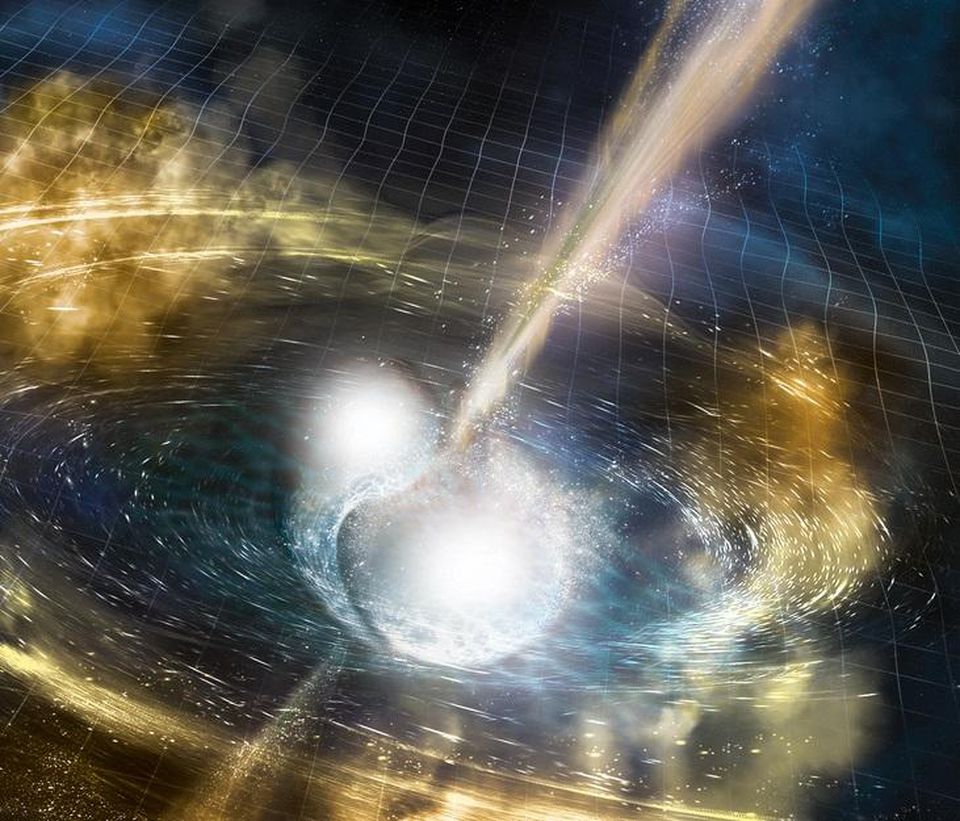
Artistic illustration of the merger of two neutron stars. The space-time grid covered with waves represents gravitational waves emitted during a collision, and the rays are jets of gamma radiation firing several seconds after the gravitational waves (astronomers detect them in the form of gamma bursts ). In such an event, the mass turns into two types of radiation.
In Einstein's general theory of relativity, a model of the Universe that gives exact solutions can be constructed in just a few ways. We can accurately describe the space-time in an absolutely empty universe. If you place a single mass in an empty universe, the task will become much more difficult, but the solution can still be written. And if you put the second mass in such a universe, the task will not be solved. We can only make estimates, and try to come to a numerical solution. This annoyingly complex property of space-time, the fact that it is so hard to accurately describe, and forces us to use such enormous computer power, efforts in theoretical research, and spend so much time to properly simulate the fusion of black holes and neutron stars, recorded by LIGO .
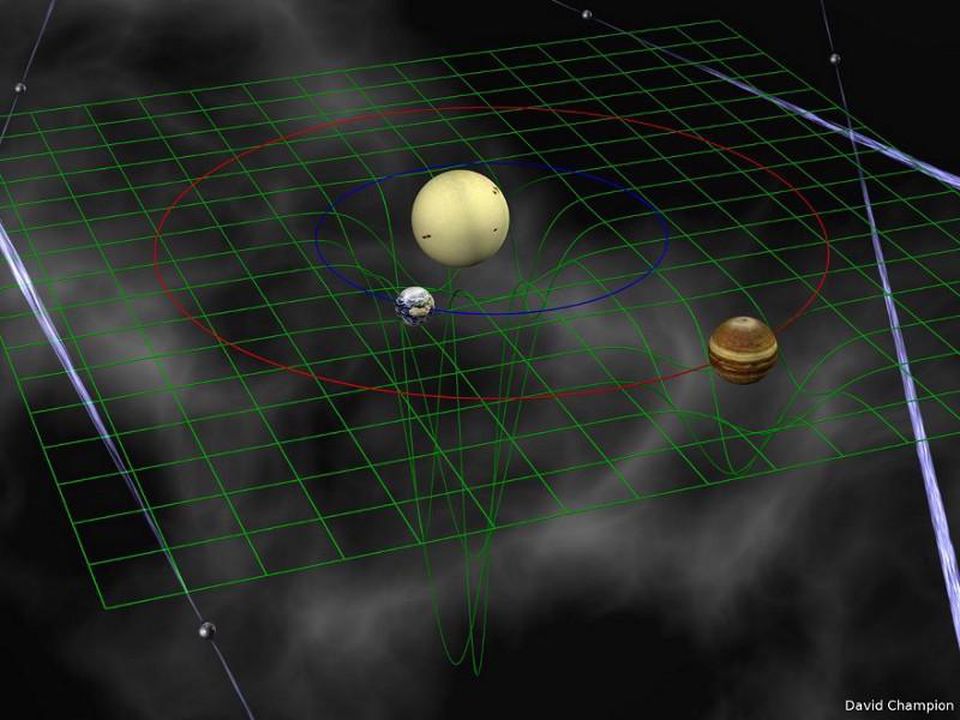
The work of gravity is determined not only by the location and magnitude of the masses, but also by how these masses move relative to each other and accelerate in a gravitational field changing with time. In GR, a system containing more than one mass cannot be exactly solved.
One of the few cases in which we can find the exact solution describes a universe filled with an equal amount of “matter” everywhere and in all directions. It doesn’t matter what the “substance” is. It can be a set of particles, a liquid, radiation, a property of the space itself, a field with the desired properties. It can be a mixture of different things, for example, normal matter, antimatter, neutrino, radiation, and even mysterious dark matter and dark energy.
If this describes your universe, and you know in what proportions you have all these substances, you only need to measure the rate of expansion of the universe. After that, you will immediately find out how it has expanded throughout your life, and will expand in the future. If you know what the universe is made of and how it expands today, you can find out the fate of the whole universe.

The expected options for the development of the universe (the top three) correspond to the universe in which matter and energy struggle with the initial rate of expansion. In our observable universe, cosmic acceleration is associated with some type of dark energy, currently unexplained. All of these universes are governed by Friedman equations .
Conducting these calculations on the basis of the Universe observed by us today, we get that it consists of:
- 68% dark energy
- 27% of dark matter
- 4.9% normal matter
- 0.1% neutrino,
- 0.01% radiation
And a negligible number of other components: curvature, antimatter, cosmic strings, and everything else that you can imagine. The total uncertainty in the quantities of the listed components does not exceed 2%. We also learned the fate of the universe - that it will expand forever - and its age: 13.8 billion years from the Big Bang. This is a remarkable achievement of modern cosmology. Illustrated timeline of the history of the universe. If the amount of dark energy is small enough to allow the first stars to form, then the appearance of the necessary ingredients for life in the Universe is almost inevitable. And our existence confirms this fact with you.
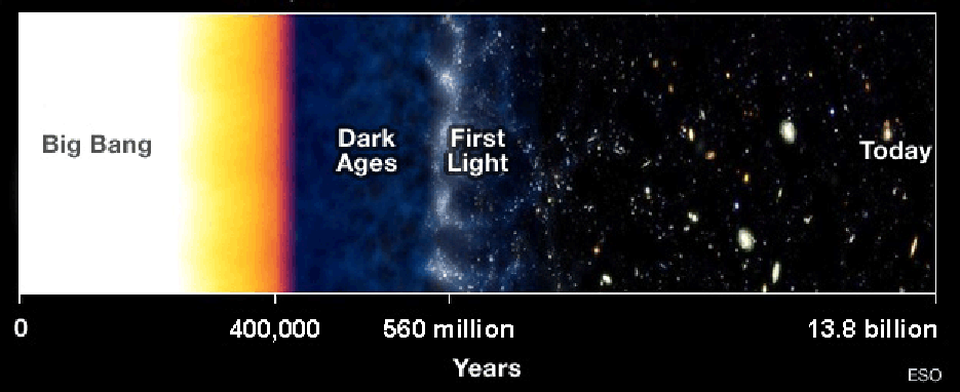
But all these calculations are carried out on the basis of our model of the Universe, which is close to a uniform distribution of substances throughout the Universe in all directions. In the real universe, as you can see, everything is crumpled. There are planets, stars, clots of gas and dust, plasma, galaxies, clusters of galaxies, and great cosmic filaments connecting them . There are huge cosmic voids , sometimes extending for billions of light years. A mathematically ideally uniform universe is called homogeneous, and our universe is surprisingly inhomogeneous. It is possible that all our ideas, on the basis of which we have made these conclusions, are incorrect.
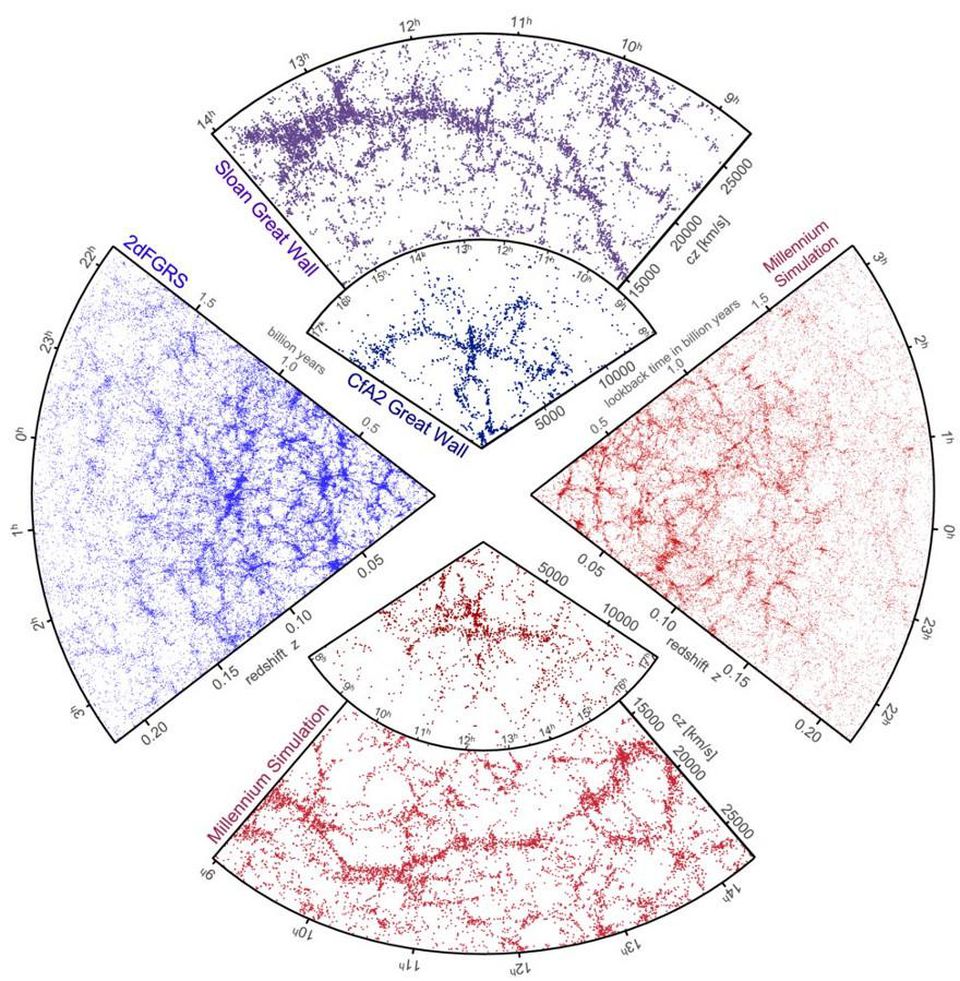
Simulations (red) and observations of galaxies (blue / magenta) show similar patterns of clusters on large scales. On a small scale, the universe is inhomogeneous.
However, on a large scale, the universe is homogeneous. If you look at the small scales, the size of a star, a galaxy or a galactic cluster, you will find the presence of areas of much greater or lower density than the average. But if we study the scale in size from 10 billion light years, then the Universe seems on average approximately the same in all places. On the largest scale, the universe is more than 99% homogeneous.
Fortunately, we can numerically estimate how good (or bad) our assumptions are by calculating the result of inhomogeneous perturbations on top of large-scale homogeneity. I myself didsuch calculations in 2005, and found that the contribution of inhomogeneity in the expansion rate does not exceed 0.1%, and that it does not behave like dark matter.
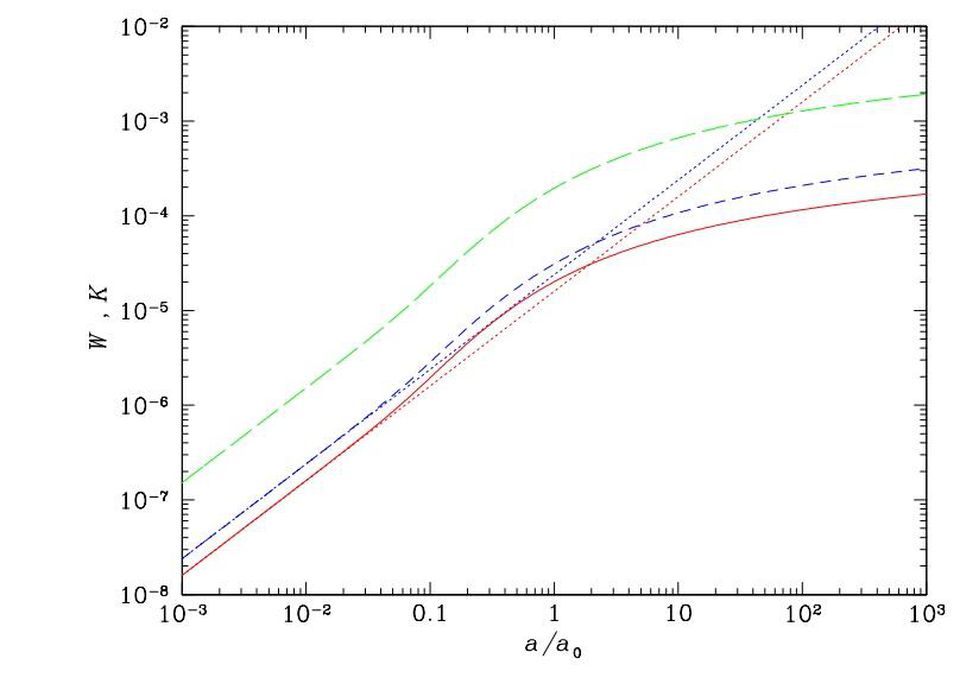
Fractional contributions of gravitational potential energy W (line with a long stroke) and kinetic energy K (solid line) to the total energy density of the Universe, constructed as a function of the past and future expansion of the Universe, where there is matter, but no dark energy. The line with a short stroke denotes the sum of the contributions of inhomogeneous factors. Dotted lines show results obtained from linear perturbation theory.
But one more possibility is connected with these calculations - certain types of energy can move from one form to another over time. In particular, thanks to:
- burning nuclear fuel inside the stars,
- gravitational collapses of clouds turning into dense objects,
- the fusion of neutron stars and black holes,
- approaching in a spiral of many gravitational systems,
matter, or mass, can turn into radiation, or energy. In other words, it is possible to change the behavior of gravity in the Universe, and to influence its expansion (or contraction) with time.

Although we have seen the merging of black holes in the Universe many times, we know that there are even more of them. LISA will allow us to predict, sometimes in a few years, exactly when the supermassive black holes will merge.
When two black holes merge together, a fairly large part of the mass can turn into energy: flesh up to 5%. In the first confluence of two black holes, discovered by LIGO, the BH of 36 solar masses and the BH of 29 solar masses merged, and formed one BH of 62 solar masses. What happened to the 3 solar masses? They turned into energy in the form of gravitational waves, according to Einstein E = mc 2 .
Therefore, the question boils down to the following: how does the transition from mass to radiation affect the expansion of the Universe? In their recent work, Nick Gorkavy and Alexander Vasilkov declare that it is capable of creating repulsive, anti-gravity force.
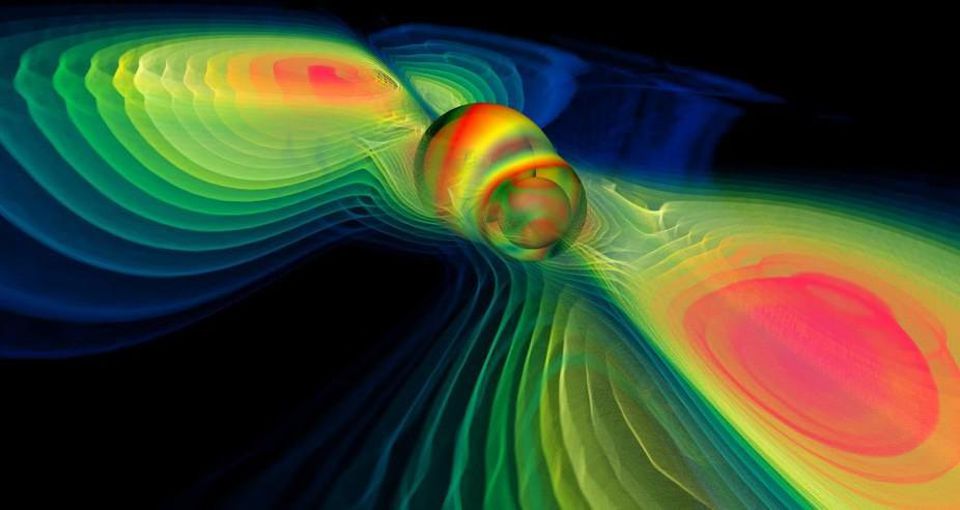
Computer simulation of the merger of two black holes, generating gravitational waves. When mass turns into radiation, is repulsive force possible?
Unfortunately, this statement is based on the fact that it only seems to be anti-gravity. When we have a certain amount of mass, we experience a certain gravitational attraction to it: this is also true in Einstein's theory, and in Newton's theory for gravity. If we transform mass into energy and radiate it outward at the speed of light, with which all massless radiation moves, when this radiation passes by us, we find that the force of attraction to the mass suddenly weakened.
The curvature of space-time changes, and where we first experienced a gravitational attraction of a certain magnitude, we will begin to experience attraction by 5% less. Mathematically, this is equivalent to the appearance of a repulsive, anti-gravity force to the system. But in fact, you will experience this reduced attraction due to the conversion of mass into energy, and the gravity of radiation acts differently (especially when it has passed you). This was described quite clearly [in response to the above work].
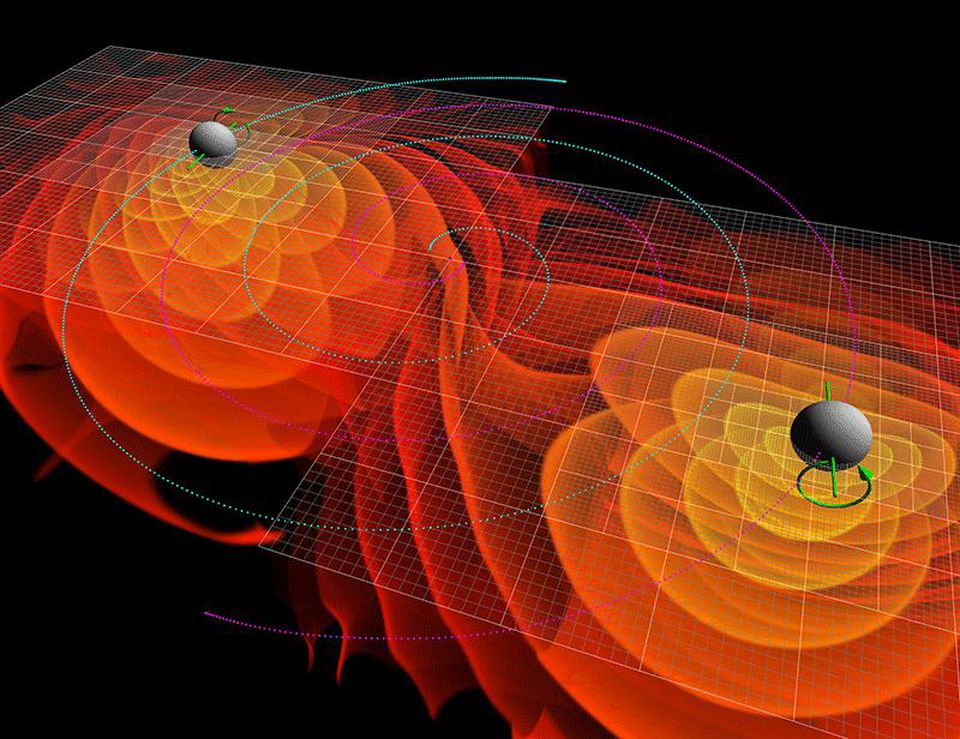
Any object or form, physical or non-physical, will be distorted when gravitational waves pass through it. Each time, when one large mass moves with acceleration through a portion of the curved space-time, gravitational waves become the inevitable consequence of this movement. However, we can calculate the effect of this radiation on space, and it does not lead to repulsion or accelerated expansion.
We can go even further and calculate how this transformation affects the entire Universe! We can numerically estimate the contribution of gravitational waves to the energy density of the Universe, and how much of the energy of the Universe is emitted by all types of radiation.. Radiation, like mass, is quantized; therefore, with an increase in the volume of the Universe (as distances in a cube), the density of particles decreases (inversely proportional to a cube of a distance). But, unlike mass, radiation has a wavelength, and with the expansion of space, this length increases, and the frequency decreases in inverse proportion to the distance. Radiation becomes gravitationally less important faster than matter.
We also need to get the correct equation of state. Matter and radiation change with time, but dark energy maintains a constant density throughout space as the universe expands. Moving forward in time, we see that the problem is only getting worse; dark energy dominates more and more, matter and radiation become less important.
Matter and radiation carry an attracting force and slow down the Universe, but none of these phenomena can remain dominant in energy density while the Universe expands.

Blue shaded area - possible uncertainties in the density of dark energy in the past and future. The data indicate that this is a true cosmological constant, while we do not refuse other possibilities. Unfortunately, the transformation of matter into energy is unable to play the role of dark energy; what used to behave like matter now behaves like radiation.
If we want to create an Universe with an accelerated expansion, then, judging by our best knowledge, we need a new form of energy that is different from the already known ones. We called this form dark energy, although we are not 100% sure of its nature.
However, despite our ignorance in this area, we can very clearly determine what dark energy is not. These are not stars that burn their fuel; it is not matter emitting gravitational waves; these are not the consequences of gravitational collapse; it is not the result of mergers or convergence in a spiral. It is possible that some new law will eventually replace the laws of Einstein, but in the context of GR, it is impossible to explain our current observations with the help of well-known physics. We have to discover something truly new.
